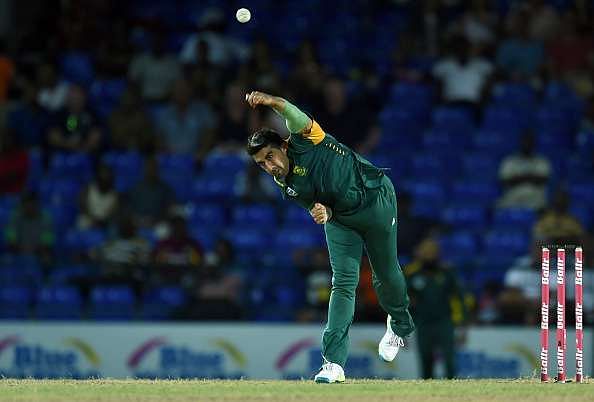
Are South African spinners providing balance to the side’s pace-heavy bowling attack?
South Africa, for a long long time, has been known to produce lethal, fast as lightning (read Allan Donald) bowlers. However, the African nation is now slowly emerging into a paradise for spin bowlers. The increasing number and variety of spinners in the country, balancing the pace-dominant bowling attack, is becoming a huge advantage for the Proteas.
Also Read: Top 10 spinners of all time in Test cricket
The dominance of the pacers
Until four or five years ago, South Africa was a land of pacers, and pacers alone, spearheaded then and now by Dale Steyn.
When New Zealand visited South Africa this year for a two-match test series, all eyes were on Steyn, who was set to make a comeback to Test Cricket after having played his last test for the Proteas in December 2015. Two test and ten wickets later, Steyn had made a royal comeback.
Not just in the longest format, but across all the others too, his average has been brilliant. While in the rest of the world, the Proteas have averaged 33.75, in the same period, Steyn alone averaged 23.26 in 34 matches away.
However, it is not only about Steyn. South Africa’s pacers have made full use of the home advantage, much better than other countries, averaging 25.40 since 2006. They have been more productive than other quicks in their respective backyards.
Top order collapses in the last decade have been frequent in South Africa, courtesy the pace brilliance. There was a time when the visiting teams would collapse for under 150 in nearly every second innings. Pacers in the country have taken 85.5% wickets, accounting for the highest figure by quicks in any team.
One of the all-time famous pace attacks by the Proteas was seen vs Sri Lanka in 2014 when Steyn and Morne Morkel together picked up 16 wickets, 7 of which came on the final day of the test. The role of the spinners was almost negligible, with Imran Tahir going wicket-less and giving away the most number of runs.
South Africa clearly struggled to introduce an attacking spinner since Paul Adams, but that was only until the recent past.
Emergence of Imran Tahir
While Tahir may still seem to be a hit and miss in the longer format, he surely has risen to challenge in the limited overs game. He has shown remarkable pliability of skill and spirit by re-introducing himself as a star in the shorter formats.
The leg spinner is his team’s leading current, an influential Twenty20 bowler in terms of average and strike rate, and second in terms of economy rate stakes. There have been only 3 South Africa bowlers who have taken more wickets for the side than Tahir, namely Wayne Parnell, Morne Morkel and Dale Steyn.
But Tahir, along with Morkel and Steyn, has bagged a four wickets haul twice. This is certainly not a poor record for a spinner in a quicks-dominated attack, especially in a format where the mind game is trumped by the muscles.
His potential was seen in the T20 series against England in February 2016, when he topped the economy rates and the averages chart. In the series against Australia which followed, his five wickets made him the joint leading wicket-taker along with Kagiso Rabada.
Spoilt for choice with spinners
South Africa is literally spoilt for choice with so many new spinners in the team. Aside Imran Tahir, there has been further development in the spin department, which now boasts of names like Dane Piedt, Simon Harmer, Eddie Leie, Aaron Phangiso, Tabraiz Shamsi and Keshav Maharaj.
The recent West Indies triangular series was a case in point in highlighting South Africa’s production of quality spinners.
After many, many years, South Africa was seen playing 3 spinners in few of the matches, and that explained the pace attack now enjoys a new partner. South Africa’s reticence in playing spinners as specialists finally paid off.
RSA is now upbeat about the flexibility of their spinners, and happy about the fact that they can feature across different formats.
This was apparent last year, as already discussed, when Tahir produced a five-wicket haul in an innings against India. He captured his 100th ODI scalp in only his 58th match international match, a manifestation of his world-class stature in limited overs game.
Talking of Tabraiz Shamsi, the spinner took 41 wickets in the seven matches played in Sunfoil Series, South Africa’s domestic first-class tournament, averaging at 19.97. Following that, in his first match of the Caribbean triangular series, against Australia, he took 1-38, but a total of three leg-before-wicket-shouts went unanswered in the consent department.
Nine wickets fell to spinners in that match in Guyana where South Africa defended their meagre score of 189 to snatch away a 47-run win against Australia. Parnell, Tahir and Phangiso took two wickets each, while ODI debutant Shamsi took 1.
Together, Shamsi and Tahir have taken more than 1000 first-class wickets. Shamsi has dismissed 272 batsmen in his 68 first-class matches, a record which speaks for itself.
On the other hand, Piedt took 39 wickets in the 2015/2016 cricket season at an average of 22.33. Maharaj was also commendable for Sunfoil Dolphins. Another wrist spin specialist is Eddie Leie, one of the finest proponents of the googly in South Africa.
The country now has an off-spinner, a left-arm spinner, leg spinners and also a left-arm wrist spinner. This variety can definitely help the side move up to the top of the rankings in all formats.
Tahir will be playing in the upcoming ODIs against Australia and Ireland, with Tabraiz Shamsi and Aaron Phangiso also in the squad, the combination looks strong enough to bamboozle the opposition batsmen.



